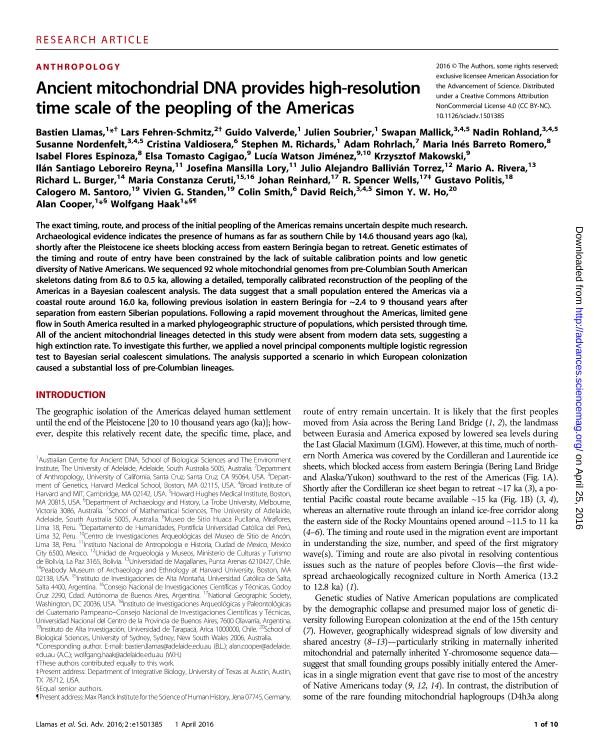Artículo
Ancient mitochondrial DNA provides high-resolution time scale of the peopling of the Americas
Llamas, Bastien; Fehren Schmitz, Lars; Valverde, Guido; Soubrier, Julien; Mallick, Swapan; Rohland, Nadin; Nordenfelt, Susanne; Valdiosera, Cristina; Richards, Stephen M.; Rohrlach, Adam; Romero, Maria Inés Barreto; Espinoza, Isabel Flores; Cagigao, Elsa Tomasto; Jiménez, Lucía Watson; Makowski, Krzysztof; Reyna, Ilán Santiago Leboreiro; Lory, Josefina Mansilla; Torrez, Julio Alejandro Ballivián; Rivera, Mario A.; Burger, Richard L.; Ceruti, Maria Constanza ; Reinhard, Johan; Wells, R. Spencer; Politis, Gustavo; Santoro, Calogero M.; Standen, Vivien G.; Smith, Colin; Reich, David; Ho, Simon Y. W.; Cooper, Alan; Haak, Wolfgang
; Reinhard, Johan; Wells, R. Spencer; Politis, Gustavo; Santoro, Calogero M.; Standen, Vivien G.; Smith, Colin; Reich, David; Ho, Simon Y. W.; Cooper, Alan; Haak, Wolfgang
 ; Reinhard, Johan; Wells, R. Spencer; Politis, Gustavo; Santoro, Calogero M.; Standen, Vivien G.; Smith, Colin; Reich, David; Ho, Simon Y. W.; Cooper, Alan; Haak, Wolfgang
; Reinhard, Johan; Wells, R. Spencer; Politis, Gustavo; Santoro, Calogero M.; Standen, Vivien G.; Smith, Colin; Reich, David; Ho, Simon Y. W.; Cooper, Alan; Haak, Wolfgang
Fecha de publicación:
04/2016
Editorial:
Science Advances is the American Association for the Advancement of Science
Revista:
Science Advances
ISSN:
2375-2548
Idioma:
Inglés
Tipo de recurso:
Artículo publicado
Clasificación temática:
Resumen
The exact timing, route, and process of the initial peopling of the Americas remains uncertain despite much research. Archaeological evidence indicates the presence of humans as far as southern Chile by 14.6 thousand years ago (ka), shortly after the Pleistocene ice sheets blocking access from eastern Beringia began to retreat. Genetic estimates of the timing and route of entry have been constrained by the lack of suitable calibration points and low genetic diversity of Native Americans. We sequenced 92wholemitochondrial genomes from pre-Columbian South American skeletons dating from 8.6 to 0.5 ka, allowing a detailed, temporally calibrated reconstruction of the peopling of the Americas in a Bayesian coalescent analysis. The data suggest that a small population entered the Americas via a coastal route around 16.0 ka, following previous isolation in eastern Beringia for ∼2.4 to 9 thousand years after separation from eastern Siberian populations. Following a rapid movement throughout the Americas, limited gene flow in South America resulted in a marked phylogeographic structure of populations, which persisted through time. All of the ancient mitochondrial lineages detected in this study were absent from modern data sets, suggesting a high extinction rate. To investigate this further, we applied a novel principal components multiple logistic regression test to Bayesian serial coalescent simulations. The analysis supported a scenario in which European colonization caused a substantial loss of pre-Columbian lineages.
Palabras clave:
Americas
,
Peopling
,
Ancient Dna
,
Pre-Columbian
Archivos asociados
Licencia
Identificadores
Colecciones
Articulos(CCT - SALTA-JUJUY)
Articulos de CTRO.CIENTIFICO TECNOL.CONICET - SALTA-JUJUY
Articulos de CTRO.CIENTIFICO TECNOL.CONICET - SALTA-JUJUY
Citación
Llamas, Bastien; Fehren Schmitz, Lars; Valverde, Guido; Soubrier, Julien; Mallick, Swapan; et al.; Ancient mitochondrial DNA provides high-resolution time scale of the peopling of the Americas; Science Advances is the American Association for the Advancement of Science; Science Advances; 2; 4; 4-2016; 1-10
Compartir
Altmétricas



